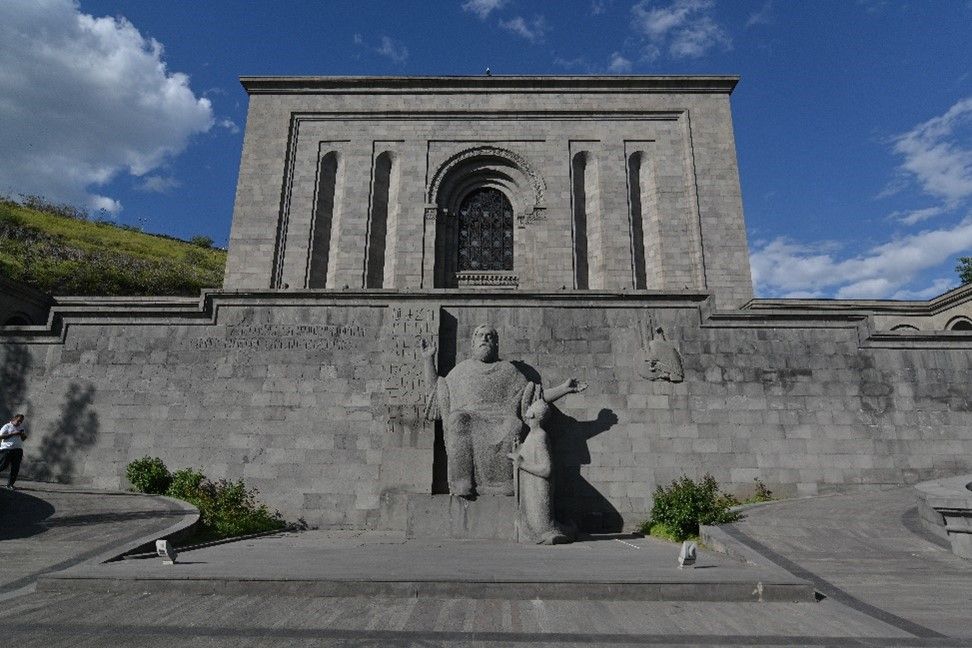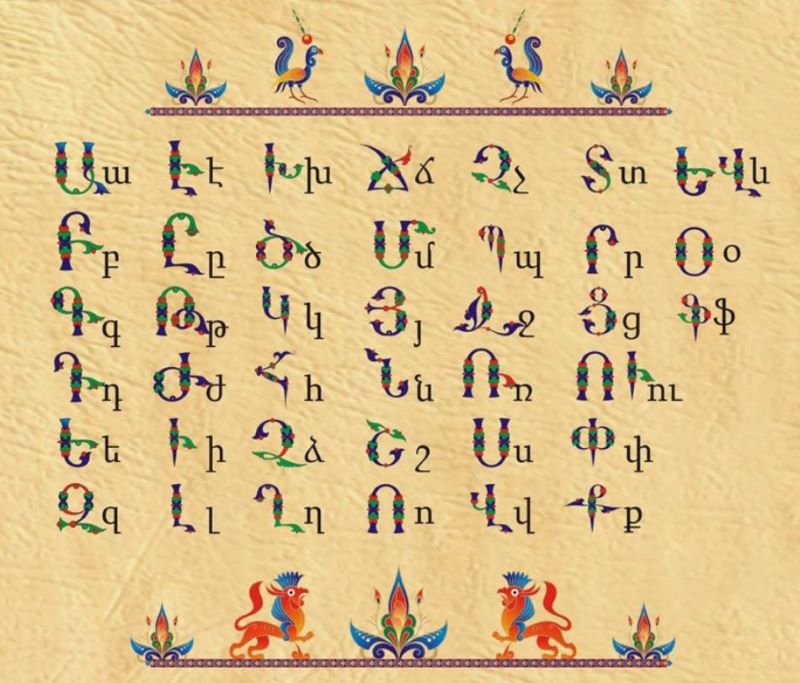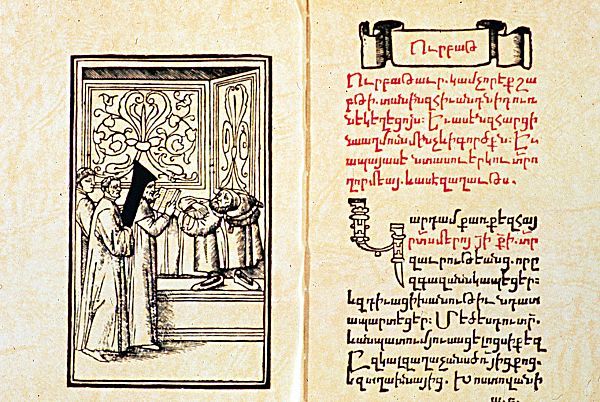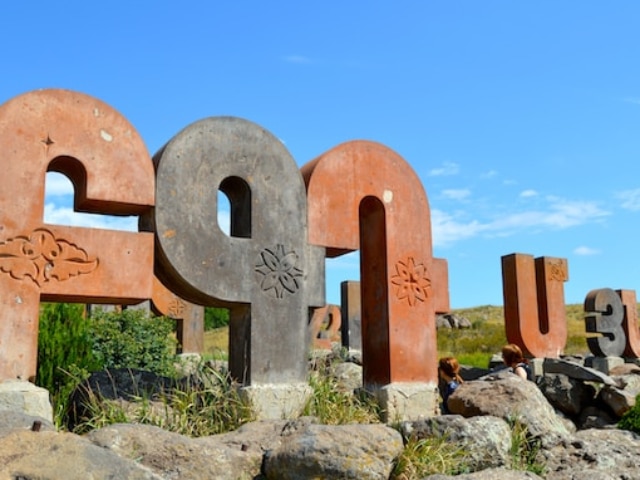
When traveling to Armenia, many tourists visit the monument to Armenian letters. It’s a monument that consists of 39 big carved Armenian letters in Aragatsotn province. Here you can really feel how Armenians are proud of their unique alphabet.
There is a fascinating history behind the creation of the Armenian letters. One cannot underestimate the significance of this linguistic gem for the Armenian culture as it stands as a testament to the country’s enduring cultural identity.
From its origins in the 5th century to its evolution as a symbol of the Armenian nation, each letter tells a story. Let’s explore how the letters shaped Armenian literature, art, and identity. This blog will reveal the history and secrets of the Armenian alphabet.
Armenian Language
The Armenian language, belonging to the Indo-European language family, holds a unique status as an independent branch of this family. As the official language of Armenia, it boasts a global community of approximately 7 million speakers.
Armenian speakers mostly live in Armenia, Russia, the United States, Georgia, France, Iran, Lebanon, and other countries. Renowned for its historical significance, a study by the Massachusetts Institute of Technology identifies Armenian as one of the 50 most influential and ancient languages worldwide.
Notably, Armenian stands among the ancient scripts within the Indo-European languages. Throughout its extensive history, the Armenian language has interacted with various Indo-European and non-Indo-European languages, both living and extinct, assimilating and preserving linguistic elements not documented elsewhere.
There are several distinct varieties of the Armenian language, including Classical Armenian (Grabar), Middle Armenian, and Modern Armenian (Ashkharabar). Modern Armenian, developed in the 19th century, is divided into two forms: Western Armenian and Eastern Armenian. Furthermore, numerous dialects are spoken with approximately 50 dialects documented before the 20th century.
History of the Armenian Alphabet

Mesrop Mashtots, a medieval Armenian linguist and theologist, created the Armenian alphabet in 405. Before creating the Armenian letters, Mashtots meticulously studied other alphabets at that time—Greek, Assyrian, Persian, and Aramaic. His goal was to determine whether these alphabets apply to the Armenian phonetic system.
Once the research was over, he realized that Armenian phonetics was unique and that it was not possible to express the sounds in any existing alphabet. Phoenician, Greek, or Latin did not have letters that could adequately capture the distinct phonetic nuances of the Armenian language. Consequently, Mashtots crafted an Armenian alphabet with 36 letters, each corresponding to the phonetic composition of the language. Seven conveyed vowel sounds and 29 conveyed consonant sounds. Two more letters were added in the 11th century.
In the ancient world, letters often served a dual purpose, also functioning as numbers. Thus, Mesrop Mashtots organized the 36 letters of the Armenian alphabet into four rows, assigning distinct numerical values. The first row represented units, the second – tens, the third indicated hundreds, and the fourth signified thousands.
Moreover, Mashtots wrote the first Armenian sentence. It is the first sentence from Solomon’s Book of Proverbs: “To know wisdom and instruction; to perceive the words of understanding”.
First Armenian Book

The Urbatagirk, known as “The Book of Fridays,” marks a pivotal moment in Armenian literary history as the first printed book in the Armenian language. Published in Venice in 1512 by Hakob Meghapart, this groundbreaking work holds a unique place in Matenadaran.
The book published by Hakob Meghapart played a crucial role in preserving the Armenian language and literary tradition. It was written in Classical Armenia. Comprising 124 pages with 24 illustrations, the book featured a blend of religious and secular content. It contains prayers for the sick, ancient writings, and excerpts from Grigor Narekatsi’s Book of Lamentations.
The red and black ink printing, mimicking manuscript writing, showcases the book’s intricate design. There are also decorative frames and titles on the pages. The publishers used rounded letters (bologir style) and capital letters. Both the National Library of Armenia and the Mekhitarist Congregation at San Lazzaro degli Armeni in Venice proudly safeguard copies of this historic masterpiece.
Matenadaran
Matenadaran, the Mesrop Mashtots Research Institute of Ancient Manuscripts in Yerevan, is the guardian of the unique pieces. Established in 1959, Matenadaran safeguards over 23,000 manuscripts, showcasing the evolution of the Armenian language and culture.
At its entrance, a statue of Mesrop Mashtots stands proudly, honoring the alphabet’s creator. Matenadaran’s significance lies in preserving the calligraphy and rare manuscripts and books. The Institute has a collection of old printed books, it houses the original “Urbatagirk” book printed in Venice as well as other books printed in the same publishing house. There is also the first Armenian Bible by Voskan Yerevantsi which was printed in 1666 in Amsterdam.
The repository also contains the biggest Armenian book “Msho Charyntir” which weighs 28 kilograms. The smallest manuscript weighs only 19 grams and is a church calendar of the 16th century.
Monument to Armenian Letters

Armenians are so proud of their letters that they installed a monument to praise this profound symbol of linguistic heritage and cultural pride. Unveiled in 2005 to commemorate the 1600th anniversary of the Armenian alphabet’s creation, the monument is located in Aragatsotn Province against the backdrop of Mount Aragats.
The monument created by architect Jim Torosyan honors Mesrop Mashtots who was buried at a chapel in the village of Oshakan, around 20 kilometers far from the monument. There is also a statue of Mashtots himself. This monument is one of the most popular tourist spots in Armenia. The letters are near Yerevan and are on the way to famous tourist destinations, so most travelers stop by to take a photo near the first letter of their name.
